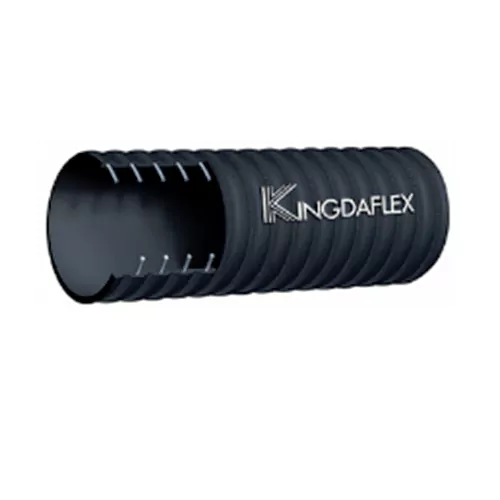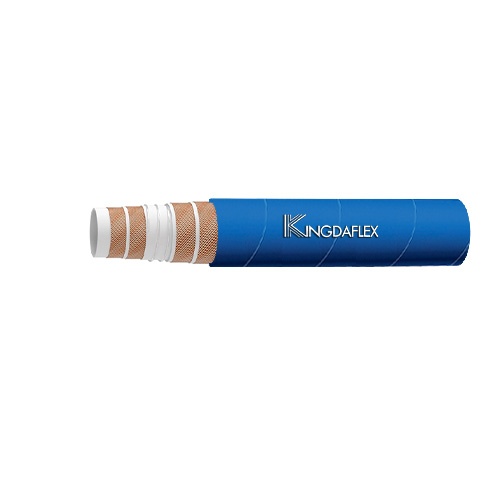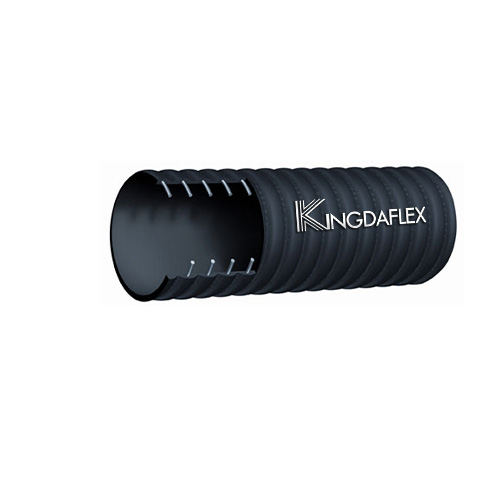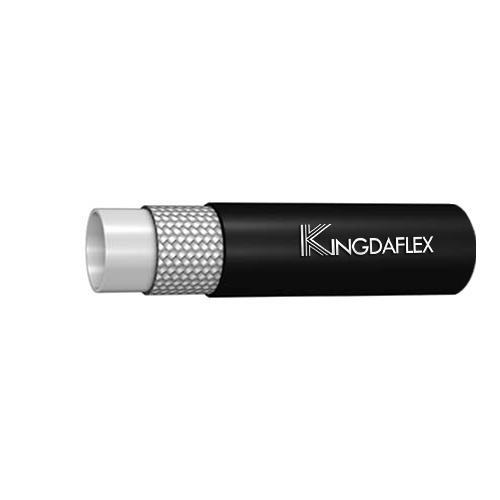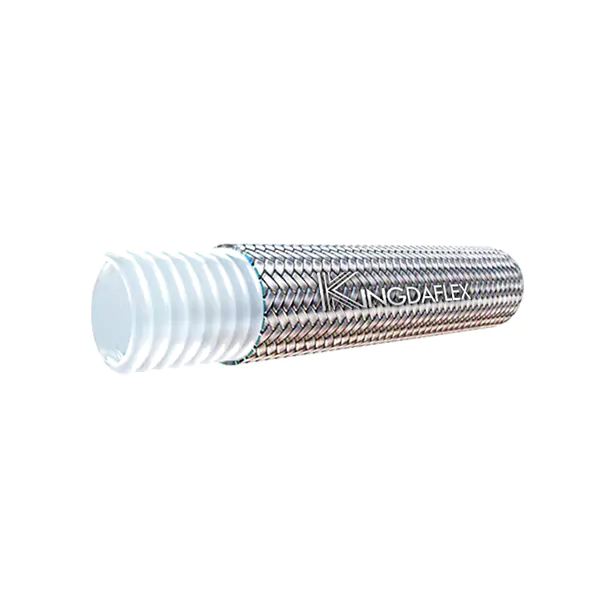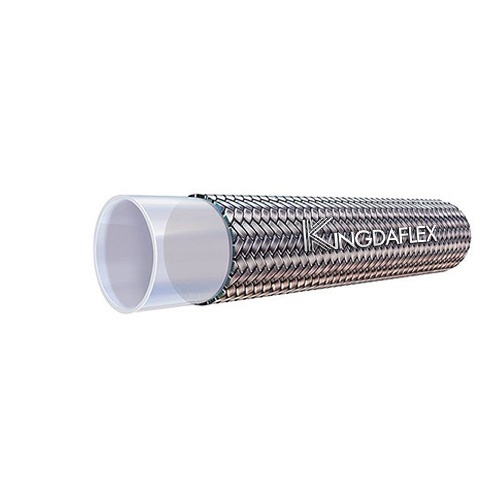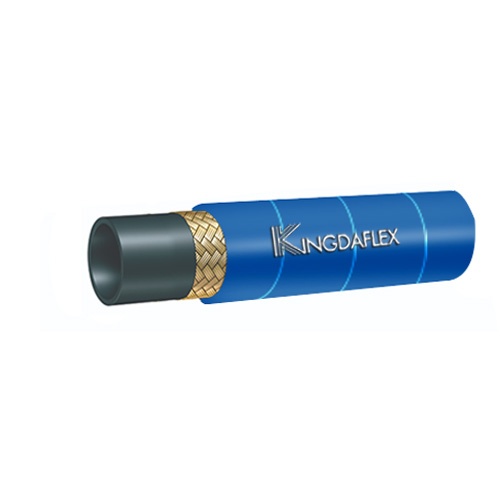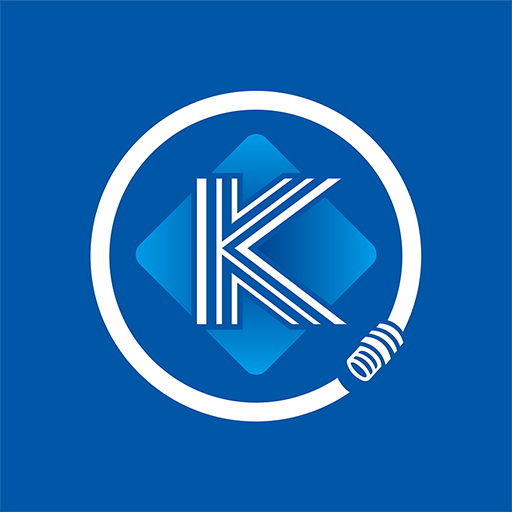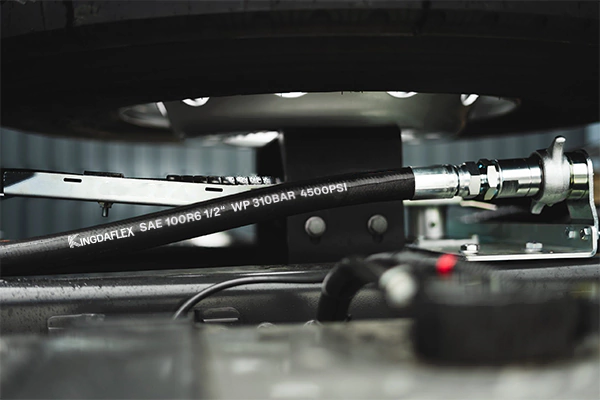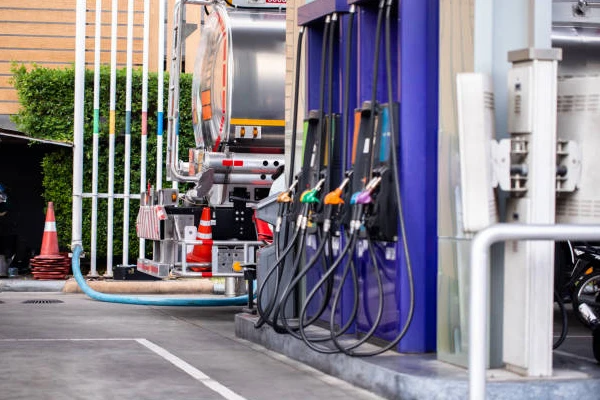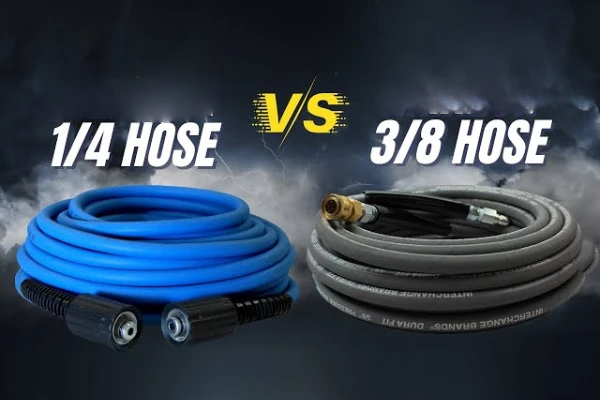Kingdaflex engineers specialty hydraulic hoses for extreme environments where standard SAE hoses fail. From 10,000 PSI high-pressure lines to -55°C arctic-grade rubber, we provide custom-manufactured solutions for mining, aerospace, and heavy industry. OEM & Private Label Available.
Why Choose Kingdaflex for Specialty Applications?
Standard SAE hoses work for general machinery, but critical operations require specialized engineering. We focus on three core performance pillars:
- Extreme Durability: Up to 1,000,000 impulse cycles for our 4SH/4SP spiral hoses.
- Material Innovation: Using PTFE, UHMWPE, and Aramid fibers for superior chemical and abrasion resistance.
- Custom Validation: Every specialty batch undergoes Proof Pressure Testing (2x W.P.) before shipment.
Types of Specialty Hydraulic Hoses
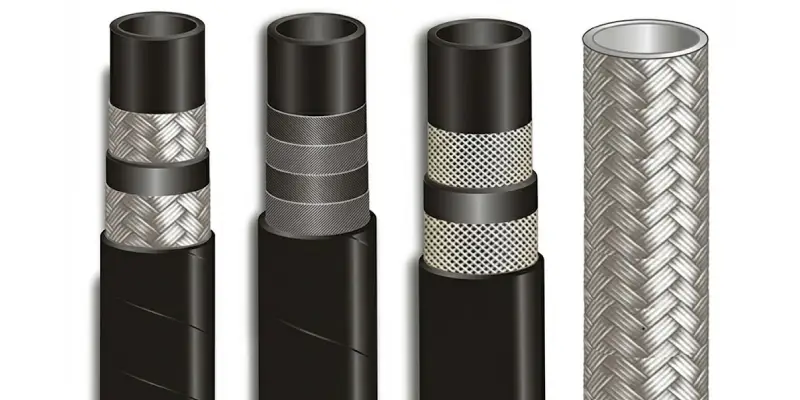
Specialty hydraulic hoses are designed to excel in conditions where standard hoses would fail. Their construction varies significantly to accommodate specific environmental, pressure, and fluid handling requirements, ensuring optimal system performance and longevity.
Understanding these different types is crucial for selecting the right hose for your unique application, preventing costly failures and maximizing operational efficiency. Each type offers distinct advantages.
Extreme High-Pressure Hoses
Engineered for heavy-duty hydrostatic drives and mining equipment. These hoses utilize multi-spiral steel wire reinforcement to handle massive pressure spikes.
- Key Models:
- DIN EN856 4SH / 4SP: 4-Wire Spiral (Up to 420 Bar / 6090 PSI).
- SAE 100 R13 / R15: 6-Wire Spiral (Up to 420 Bar constant pressure).
- Performance: Rated for 500,000 to 1,000,000 impulse cycles.
- Application: Excavators, Hydraulic Presses, Blow-out Preventers (BOP).
High-Temperature & Steam Hoses
Standard rubber hardens and cracks above 100°C. Our specialty high-temp series uses premium elastomers and fluoropolymers.
- PTFE (Teflon) Hose:
- Temp Range: -60°C to +260°C.
- Feature: Chemically inert, handles steam, hot oil, and corrosive chemicals. Stainless steel braided.
- Blue High-Temp Hydraulic Hose:
- Temp Range: Up to +135°C (continuous) / +150°C (intermittent).
- Feature: Specialized CPE rubber compound for hot engine compartments.
Low-Temperature Hydraulic Hoses
Designed for cold storage facilities and machinery operating in polar regions. Standard hoses become brittle and shatter below -20°C; ours remain flexible.
- Temp Range: Maintains flexibility down to -55°C (-67°F).
- Standard: Exceeds SAE 100 R1AT / R2AT low-temp requirements.
- Application: Snow groomers, Siberian oil fields, Cold storage forklifts.
Abrasion-Resistant Hydraulic Hoses
These hoses are built with robust outer covers designed to resist wear and tear from friction, dragging, and contact with rough surfaces. The covers are typically made from highly durable synthetic rubber or thermoplastic compounds.
Benefits:
- Extended lifespan in harsh, abrasive environments: Durable outer covers withstand constant rubbing, dragging, and impact from rough materials.
- Reduced maintenance and replacement costs: Less frequent hose failure means significant savings on parts and labor over time.
- Protects internal hose components from external damage: The tough exterior safeguards reinforcement layers and inner tube, preventing premature failure.
Where to Use:
- Mining and quarrying operations: Endures constant contact with rocks, dust, and sharp debris on heavy equipment.
- Forestry and logging equipment: Resists abrasion from tree branches, stumps, and rough terrain during timber operations.
- Agricultural machinery (e.g., harvesters, tillers): Withstands continuous rubbing against soil, crops, and field residue.
- Any application where hoses are frequently dragged or exposed to rough surfaces: Ideal for mobile equipment lines that experience constant external wear.
Chemical-Resistant Hydraulic Hoses

Specifically engineered to handle a wide range of corrosive chemicals, acids, bases, and solvents without degradation. They feature inner tubes made from specialized synthetic rubbers or fluoropolymers that are inert to specific chemicals.
Benefits:
- Prevents chemical attack and material breakdown: Inner tube materials resist degradation from aggressive fluids, ensuring hose integrity.
- Ensures safe and contaminant-free fluid transfer: Prevents chemical leaks and avoids contamination of the conveyed fluid or environment.
- Longer service life when handling aggressive fluids: Reduces the need for frequent replacement in chemically harsh operating conditions.
Where to Use:
- Chemical processing plants: Essential for conveying various acids, bases, and reactive compounds within industrial processes.
- Pharmaceutical manufacturing: Ensures sterile and non-reactive fluid transfer for sensitive drug production.
- Food and beverage industries (for specific cleaning agents): Withstands harsh CIP (Clean-In-Place) chemicals and food-grade sanitizers.
- Oil refineries and petrochemical facilities: Handles corrosive hydrocarbons, solvents, and other aggressive petroleum products safely.
Fire-Resistant Hydraulic Hoses
These hoses are designed with outer covers that can withstand direct flame exposure for a specified period without failing, preventing fluid leaks that could exacerbate a fire. They often include fire-retardant materials.
Benefits:
- Enhanced safety in environments with fire risks: Maintains integrity during flame exposure, preventing hydraulic fluid from fueling a fire.
- Maintains integrity during emergencies, preventing fluid spread: Contains hydraulic fluid even when engulfed in flames, limiting fire escalation.
- Compliance with stringent safety regulations: Meets specific industry standards for fire resistance, crucial in high-risk applications.
Where to Use:
- Underground mining operations: Critical for preventing hydraulic fluid leaks that could ignite and create hazardous conditions.
- Offshore oil rigs and marine applications: Essential for safety where flammable materials and potential ignition sources are present.
- Steel mills and foundries: Protects hydraulic lines from extreme heat and molten metal splashes, minimizing fire hazards.
- Any industrial setting where fire hazards are prevalent: Crucial for protecting critical hydraulic systems in high-risk manufacturing or processing areas.
Suction Hose
These hoses are designed for low-pressure applications, primarily for drawing hydraulic fluid from a reservoir. They often have a thicker wall and may feature internal wire helix reinforcement to prevent collapse under vacuum.
Benefits:
- Prevents hose collapse under suction: Internal wire helix or thick walls maintain hose shape even when fluid is drawn in.
- Ensures smooth and unrestricted fluid flow: Prevents blockages or flow limitations caused by hose constriction during fluid intake.
- Durable for continuous operation: Designed for constant, efficient drawing of fluid into hydraulic systems.
Where to Use:
- Reservoir suction lines in hydraulic power units: Connects the pump inlet to the hydraulic fluid reservoir, preventing collapse under vacuum.
- Industrial machinery with fluid circulation needs: Used in various systems requiring the efficient transfer of fluids into a pump.
- Agricultural equipment for fluid intake: Common in low-pressure lines for drawing fluids for various implements.
- Any system requiring fluid intake from a tank: Ensures reliable, non-collapsing flow for pump suction.
Thermoplastic Hydraulic Hoses
Constructed without wire reinforcement, these hoses use high-strength textile braids or aramid fibers within a thermoplastic core and cover. They are often lightweight, compact, and offer excellent flexibility.
Benefits:
- Lightweight and compact design: Easier to handle, install, and route in confined spaces compared to heavier rubber hoses.
- Excellent flexibility and bend radius: Allows for tighter routing and reduces stress on connections, ideal for dynamic applications.
- Good electrical non-conductivity for specific applications: Offers insulation, important for hydraulic tools used near electrical components.
Where to Use:
- Mobile equipment requiring flexible lines: Ideal for applications with dynamic movement and limited space, like forklifts and scissor lifts.
- Hydraulic tools and lifting equipment: Used in portable power tools and small lifting devices due to their flexibility and light weight.
- Forklifts and material handling: Their flexibility and compact size are advantageous for routing in confined vehicle chassis.
- Pneumatic systems (though primarily hydraulic): Can also be used in high-pressure air systems where flexibility and non-conductivity are valued.
Power Jack Hose
Specifically designed for hydraulic jacks, these hoses meet the unique requirements for the high-pressure, often intermittent, forces involved in lifting and lowering. They combine specific pressure ratings with necessary flexibility.
Benefits:
- Optimized for high, intermittent pressure cycles: Built to withstand the specific pressure surges common in jacking operations.
- Provides necessary flexibility for confined spaces: Allows for easy routing and connection in the often tight confines of jack mechanisms.
- Ensures reliable and safe lifting operations: Critical for the secure transfer of fluid to raise and lower heavy loads effectively.
Where to Use:
- Automotive hydraulic jacks: Essential for car lifts, floor jacks, and bottle jacks in garages and workshops.
- Industrial lifting jacks: Used in maintenance facilities for heavy machinery and structural support.
- Rescue equipment: Found in hydraulic spreaders and cutters used by emergency services.
- Any application requiring portable, high-force lifting: Where compact, high-pressure lines are needed for intermittent use.
Non-Conductive Twin-Line Hose
This type features two hoses bonded together, specifically designed to prevent the transfer of electrical current. Their construction includes non-conductive layers, crucial for operator safety in electrified environments.
Benefits:
- Prevents electrical conductivity for enhanced safety: Offers crucial insulation, protecting operators from electrical shock hazards.
- Ideal for proximity to live electrical sources: Essential when hydraulic equipment operates near power lines or electrical components.
- Streamlined installation with twin-line design: Two hoses are conveniently managed as one unit, simplifying routing.
Where to Use:
- Mining equipment (e.g., roof bolters): Critical for safety where electrical systems and potential static discharge are present underground.
- Construction equipment near power lines: Used on boom lifts, bucket trucks, and diggers operating close to electrical infrastructure.
- Utility vehicles for line work: Ensures safety for workers handling power lines and electrical systems.
- Any application where electrical isolation is paramount: For operator protection in electrically charged environments.
SAE 100R14 PTFE Hose
This hose utilizes Polytetrafluoroethylene (PTFE), commonly known as Teflon, for its inner tube. This material provides exceptional chemical inertness and superior performance across a very wide temperature range.
Benefits:
- Exceptional chemical resistance: PTFE inner tube handles nearly all corrosive chemicals without degradation or contamination.
- Withstands extreme high and low temperatures: Operates reliably across a vast thermal spectrum, from cryogenic to very hot conditions.
- Low friction coefficient for smooth flow: PTFE’s non-stick surface minimizes pressure drop and prevents fluid buildup.
Where to Use:
- Aerospace fuel and hydraulic systems: Meets stringent requirements for performance in extreme temperatures and with various fluids.
- Chemical processing and transfer lines: Ideal for aggressive acids, solvents, and other highly reactive industrial chemicals.
- Food and pharmaceutical applications: Its inertness ensures no contamination of sensitive products.
- Automotive brake and power steering lines (performance applications): Provides reliability and chemical resistance with various fluids.
Push-On Hose
Designed for quick and easy connections without requiring clamps or ferrules, these hoses feature a specially formulated cover and inner tube that securely grip a barbed fitting when pushed on.
Benefits:
- Facilitates rapid and tool-free assembly: Eliminates the need for crimping or specialized tools, speeding up installation.
- Provides a secure, leak-free connection: The unique design ensures a strong grip on the barbed fitting under pressure.
- Reduces installation time and labor costs: Simplifies maintenance and repair, especially in field applications.
Where to Use:
- General industrial machinery for maintenance: Quick repairs and modifications where fluid lines need frequent disconnection.
- Pneumatic systems (low-pressure hydraulic applications): Common for air lines where ease of assembly is crucial.
- Automotive repair shops for non-critical lines: Used for various lower-pressure fluid and air connections.
- DIY and hobbyist hydraulic projects: Convenient for projects not requiring heavy-duty, crimped connections.
Water Application Hose
Specifically engineered for use with water or water-based hydraulic fluids, these hoses feature inner tubes that resist hydrolysis (degradation by water) and other water-related issues that can affect standard hoses.
Benefits:
- Resists degradation from water and water-based fluids: Inner materials prevent swelling or breakdown when exposed to water.
- Prevents contamination in water-based systems: Ensures the purity and effectiveness of the hydraulic fluid.
- Suitable for environmentally sensitive applications: Supports systems using less hazardous, water-glycol, or other water-based fluids.
Where to Use:
- Hydraulic systems using water-glycol or HFC fluids: Essential for fire-resistant and environmentally friendly hydraulic applications.
- Industrial cleaning equipment: Used for conveying high-pressure water for washing and jetting.
- Hydro-testing equipment: For pressure testing systems using water as the medium.
- Marine applications: Where exposure to water, both internal and external, is common.
Military Hose
These hoses are manufactured to meet rigorous military specifications (MIL-SPEC), ensuring superior performance, durability, and reliability under extreme battlefield or operational conditions. They undergo extensive testing for various parameters.
Benefits:
- Meets stringent military performance standards: Guaranteed to function reliably in harsh, often combat, environments.
- Exceptional durability and longevity: Built to withstand extreme temperatures, pressures, and physical abuse.
- Ensures operational readiness in critical applications: Provides dependable performance for vital military equipment.
Where to Use:
- Military ground vehicles (tanks, armored personnel carriers): For hydraulic systems controlling turrets, suspensions, and other functions.
- Naval vessels and submarines: Used in hydraulic steering, weapon systems, and other critical shipboard applications.
- Aerospace military aircraft: For flight controls, landing gear, and other vital hydraulic systems.
- Field engineering and support equipment: For hydraulic tools and machinery used in demanding military operations.
Refrigerant Hose
Used in air conditioning and refrigeration systems, these hoses are specifically designed to handle various refrigerants (e.g., R134a, R1234yf). They feature low permeation rates to prevent refrigerant loss and specific chemical compatibility.
Benefits:
- Low permeation rate for refrigerant retention: Minimizes leakage, ensuring system efficiency and compliance with environmental regulations.
- Chemical compatibility with refrigerants and oils: Inner materials resist degradation from specific refrigerant gases and compressor oils.
- Withstands pressure cycles common in HVAC/R systems: Designed for the fluctuating pressures experienced in cooling circuits.
Where to Use:
- Automotive air conditioning systems: Crucial for conveying refrigerants between compressor, condenser, and evaporator.
- Residential and commercial HVAC units: For refrigerant lines in split systems, chillers, and heat pumps.
- Industrial refrigeration systems: Used in large-scale cooling units for food processing, cold storage, and chemical industries.
- Specialty cooling equipment: Any application requiring the safe and efficient transfer of refrigerants.
High Pressure Washer Hose
Specifically designed to withstand the very high pressures generated by pressure washers, these hoses feature robust reinforcement and outer covers to resist abrasion and burst. They often have specialized fittings for quick connection.
Benefits:
- Handles extreme water pressures for powerful cleaning: Built to endure forces from hundreds to thousands of PSI for effective washing.
- Resists abrasion from dragging on rough surfaces: Durable outer jacket protects against wear during typical pressure washing use.
- Provides reliable performance in demanding cleaning tasks: Ensures consistent water flow and pressure for heavy-duty cleaning operations.
Where to Use:
- Commercial and industrial pressure washing equipment: For cleaning large surfaces, vehicles, or machinery.
- Residential pressure washers: For home cleaning tasks like driveways, siding, and decks.
- Car washes: Durable hoses withstand constant use in high-volume vehicle cleaning.
- Municipal cleaning vehicles: Used on street sweepers and drain cleaners.
Aerospace Hose (e.g., R160, qualified to AS1339)
These aerospace hydraulic hoses meet incredibly stringent aerospace standards (like AS1339), featuring advanced materials like PTFE inner cores and precision wire braid reinforcement. They are designed for critical applications where absolute reliability, weight savings, and performance in extreme conditions are paramount.
Benefits:
- Meets demanding aerospace performance and safety standards: Qualified to strict specifications for flight-critical applications.
- Exceptional reliability in extreme aerospace environments: Performs flawlessly across vast temperature and pressure ranges, and with exotic fluids.
- Lightweight construction for aircraft efficiency: Engineered to minimize weight while maximizing strength and durability.
Where to Use:
- Aircraft hydraulic systems (flight controls, landing gear): Crucial for safe and responsive operation of vital aircraft components.
- Aircraft fuel lines: Ensures reliable transfer of aviation fuels without degradation or leakage.
- Spacecraft propulsion and fluid control: Used in systems requiring ultimate reliability in vacuum or extreme conditions.
- Military aircraft and missile systems: For critical hydraulic and pneumatic functions where failure is not an option.
Hydraulax Tough(TM) Hose
This is a specific brand or series of hose known for its extreme durability and abrasion resistance. Such proprietary hoses are typically designed to outperform generic hoses in the toughest environments, offering extended life and reduced maintenance.
Benefits:
- Offers extreme durability and superior abrasion resistance: Engineered with proprietary materials for unparalleled toughness against wear.
- Extended service life in the harshest conditions: Significantly outlasts standard hoses in highly demanding applications.
- Reduces equipment downtime and replacement costs: Fewer hose failures lead to increased operational efficiency and savings.
Where to Use:
- Heavy-duty construction and demolition equipment: Where hoses are constantly exposed to impact, crushing, and rough surfaces.
- Logging and forestry machinery: For applications requiring exceptional resilience against sharp debris and intense friction.
- Mining and quarrying operations: Withstands severe abrasion from rocks and continuous dragging on rugged terrain.
- Waste management and recycling machinery: Where hoses are subject to highly abusive and abrasive operational environments.
Here’s a table summarizing the types of specialty hydraulic hoses below:
| Type of Specialty Hydraulic Hose | Key Benefit(s) | Where to Use (Examples) |
| High-Pressure Hydraulic Hoses | Superior strength, prevents bursting, reliable in demanding applications. | Heavy construction equipment, mining machinery, industrial presses, oil & gas exploration. |
| High-Temperature Hydraulic Hoses | Resists thermal degradation, maintains flexibility in hot environments, longer life. | Engine compartments, steel mills, steam lines, industrial ovens, heat processing. |
| Low-Temperature Hydraulic Hoses | Retains flexibility, prevents cracking in cold, reliable in sub-zero. | Arctic exploration equipment, refrigeration systems, outdoor machinery in cold regions, cryogenic applications. |
| Abrasion-Resistant Hydraulic Hoses | Extended lifespan, reduced maintenance, protects internal components. | Mining & quarrying, forestry equipment, agricultural machinery, any rough surface exposure. |
| Chemical-Resistant Hydraulic Hoses | Prevents chemical attack, ensures safe transfer, longer life with aggressive fluids. | Chemical processing plants, pharmaceutical manufacturing, food & beverage (cleaning agents), oil refineries. |
| Fire-Resistant Hydraulic Hoses | Enhanced safety, maintains integrity during fire, prevents fluid spread. | Underground mining, offshore oil rigs, steel mills, any industrial setting with fire hazards. |
| Suction Hose | Prevents collapse under vacuum, ensures smooth fluid flow into pump. | Reservoir suction lines, industrial machinery fluid intake, agricultural equipment for fluid drawing. |
| Thermoplastic Hydraulic Hoses | Lightweight, compact, excellent flexibility, good electrical non-conductivity. | Mobile equipment, hydraulic tools, forklifts, pneumatic systems needing flexibility. |
| Power Jack Hose | Optimized for intermittent high pressure, flexible for confined spaces. | Automotive hydraulic jacks, industrial lifting jacks, rescue equipment. |
| Non-Conductive Twin-Line Hose | Prevents electrical conductivity, enhanced safety near live electrical sources. | Mining equipment, construction equipment near power lines, utility vehicles for line work. |
| SAE 100R14 PTFE Hose | Exceptional chemical & temperature resistance, low friction. | Aerospace fuel/hydraulic systems, chemical processing, food & pharma, performance automotive. |
| Push-On Hose | Rapid, tool-free assembly, secure leak-free connection, reduces installation time. | General industrial machinery maintenance, low-pressure pneumatic systems, automotive repair, DIY projects. |
| Water Application Hose | Resists water degradation, prevents contamination, suitable for water-based fluids. | Systems using water-glycol fluids, industrial cleaning equipment, hydro-testing, marine applications. |
| Military Hose | Meets stringent military standards, exceptional durability, ensures readiness. | Military ground vehicles, naval vessels, aerospace military aircraft, field engineering equipment. |
| Refrigerant Hose | Low permeation for retention, chemical compatibility with refrigerants/oils. | Automotive A/C systems, residential/commercial HVAC units, industrial refrigeration, specialty cooling equipment. |
| High Pressure Washer Hose | Handles extreme water pressures, resists abrasion, reliable for heavy cleaning. | Commercial/industrial pressure washers, residential pressure washers, car washes, municipal cleaning vehicles. |
| Aerospace Hose | Meets strict aerospace standards, extreme reliability, lightweight for efficiency. | Aircraft hydraulic/fuel systems, spacecraft propulsion, military aircraft/missile systems. |
| Hydraulax Tough(TM) Hose | Extreme durability, superior abrasion resistance, extended service life. | Heavy-duty construction/demolition, logging/forestry, mining/quarrying, waste management. |
How to Choose Suitable Specialty Hydraulic Hoses?
Choosing the suitable specialty hydraulic hose is a critical decision that directly impacts the safety, efficiency, and longevity of your hydraulic system. It’s not a one-size-fits-all scenario, as each application presents unique challenges. A systematic approach, considering the specific demands of your operating environment, will ensure you select a hose that performs optimally and reliably, preventing costly downtime and potential hazards.
To make an informed decision, several key factors must be carefully evaluated. These considerations go beyond mere compatibility and delve into the nuances of performance under stress, environmental exposure, and regulatory compliance.
- Operating Pressure: Identify the maximum working pressure and potential surge pressures your system will experience. Always select a hose with a rated working pressure equal to or greater than your system’s maximum.
- Temperature Range: Determine both the ambient temperature and the fluid temperature extremes the hose will encounter. Choose a hose with an operating temperature range that comfortably covers these minimum and maximum values.
- Fluid Compatibility: Ensure the hose’s inner tube material is chemically compatible with the hydraulic fluid being used. Incompatibility can lead to degradation, leakage, and system failure.
- Abrasion and Environmental Factors: Assess the environment for external factors like abrasion, UV exposure, ozone, and chemical splash. Select a hose with an outer cover designed to withstand these specific conditions.
- Flexibility and Bend Radius: Consider the routing requirements and dynamic movements of the hose. Choose a hose with a minimum bend radius that can accommodate your application without kinking or stressing the hose.
- Size (Inner Diameter): The inner diameter (ID) of the hose must be appropriate for the required flow rate to prevent excessive pressure drops, heat generation, or sluggish system response.
- Length: Specify the correct length to avoid unnecessary tension, kinking, or slack that could lead to abrasion.
- End Fittings: Select fittings that are compatible with both the hose type and your system’s connection points, ensuring a secure, leak-free seal.
- Regulatory Standards: Check for any industry-specific or regulatory standards (e.g., SAE, ISO, MIL-SPEC) that your application requires the hose to meet.
- Cost vs. Performance: While cost is a factor, prioritize hose performance and longevity for specialty applications, as a cheap, unsuitable hose can lead to significant long-term expenses.
Conclusion
Understanding the diverse types of specialty hydraulic hoses is crucial for optimizing system performance and ensuring long-term reliability. By carefully considering factors like pressure ratings, temperature resistance, and material compatibility, you can select the ideal hose for even the most demanding applications.
Tailoring your hydraulic hose solutions to specific needs maximizes efficiency and minimizes downtime. Custom solutions provide the perfect fit, delivering superior performance and a longer service life, which directly impacts your operational success.
For all your wholesale specialty hydraulic hose needs, look no further than Kingdaflex. We offer a comprehensive range of high-quality, custom-engineered hoses designed to meet the unique demands of any industry.

